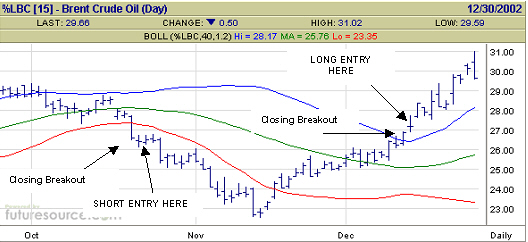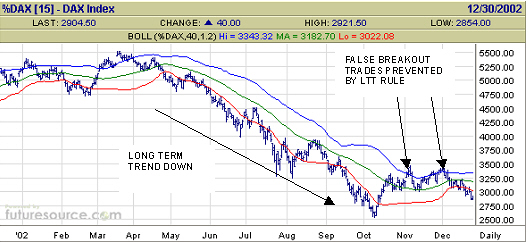Introduction
In order to properly use this system it is necessary to follow at least 7 individual markets from different futures groups. You will need this diversification in order to trade the system correctly. Some of your trades will be losses and some will be winners. There is no way to tell in advance which ones will be which.
Although it does not take a lot of time each day to calculate your buy and sell prices, it is necessary to analyse a portfolio of markets to catch the big moves that come from time to time.
One time it will be gold and next it might be soybeans. You never know, but to build big profits you need to trade big trends. You cannot afford to miss a runaway market because you have not been paying attention.
Importantly, you must pay particular attention to the money management section of this guide. Without strong and prudent risk and money management even the best trading system will fail.
The Entry
The easiest aspect of any trading system is the entry decision. The Spread Trading Secrets system uses a standard deviation of a moving average of the closing prices for entry decisions. If this sounds complicated, don’t worry.
This study is widely known as Bollinger Bands after the original user John Bollinger. I have adapted them and refer to them in this text as Breakout Bands
Almost every stock and commodity trading software or online charting service creates these bands automatically so their calculation is very simple.
Spread Trading Using Breakout Bands
Breakout Bands are a kind of trading envelope. They are lines plotted at an interval around a moving average. Breakout Bands consist of a moving average and two standard deviations charted as one line above and one line below the moving average. The line above is 1.2 (120%) standard deviations added to the moving average. The line below is 1.2 (120%) standard deviations subtracted from the moving average.
The wider the bands are, the greater the volatility is. The narrower the bands are, the lower the volatility. The moving average is calculated on the closing price of the market being studied.
The spread trading secrets system uses the bands as an entry mechanism.
Parameters (40,120)
Period – the spread trading secrets system uses a time period of 40 days.
Deviation – the spread trading secrets system uses 120% of one standard deviation to plot the upper and lower bands. This eliminates many false trades due to normal market price movements.
………………………………………………………………………………………………………………………………………………………………………………
For Long (Buy) Positions
Buy long on the open of the following trading day when the closing price moves above the upper Breakout Band.
For Short (Sell) Positions
Sell short on the open of the following trading day when the closing price moves below the lower Breakout Band.

The chart clearly shows the entry and exit criteria following a close above (or below) the breakout bands.
The Profit & Loss Filter
There is more to the system than the simple rules for entry and exit as explained. We will add to the rules using a profit and loss filter (P/L filter). The P/L filter we use is called the Last Theoretical trade (LTT).
The LTT is the single most important filter that we use in an attempt to avoid trades that have a low expectation of success. These are also known as false breakouts.
It is unlikely that a trade, which does not pass the LTT filter, will generate a large profit. However, there will be occasions when this filter does cause us to miss trades that would have been very profitable. Even during times when you do miss the large move, obeying the LTT filter consistently will keep you out of enough bad trades to more than compensate for this statistical error.
The LTT filter is very simple in its basic form and can be stated as:
After a breakout and where the market has been trending strongly for several weeks to several months, the first breakout in the opposite direction should NOT be used to initiate a new position.
The reasoning behind this filter comes from experience. Typically, the first reaction to a major price move is going to have many traders looking to get out at a breakeven or at a small loss. In addition, the major underlying trend and prevailing bias remain. These fundamental biases take time to work themselves out and do not change instantly.
It is my experience that this filter should be strictly adhered to. The historical result over long periods of trading and testing is that the profit/loss generated from breakouts that are not LTT selected are slightly negative. This is because not only is the probability of success reduced, but also a trade that is not LTT selected is very unlikely to result in a large trending move.
Our expectation is increased because we earn nearly the same profit with approximately 1/3 fewer trades by employing this filter.
The non LTT filter trades only occur after a successful trend, the type of trend which we would expect to be followed by a period of consolidation as opposed to another successful breakout.
Simply; trades after profits, in the opposite direction, are less likely to work, because the market will rarely go straight up and then straight down (or vice versa) in simultaneous smooth trends.

The chart illustrates how the LTT rule would have prevented two losing trades.
Much more likely is the scenario of alternating periods of trend and consolidation, implying that after a good trend you should expect a period of consolidation, as opposed to expecting another trend in the opposite direction. Since the spread trading secrets system success relies on capturing large moves we are wise to try to avoid the likely false breakouts.
For example:
- A major breakout has us in a short position in a profitable trade and our stop loss level is hit. At that price we exit our short position and are now flat (have no position) in that particular market.
- Applying condition 1, there is subsequently another breakout signalled to the downside, we would enter a new short position as a completely new trade.
- Applying condition 2, this would assume that the market did NOT make a new long breakout before the new short breakout.
- Applying condition 1 only, let’s suppose that over the next week or so that the market does make a new long breakout. Since this is the first upside breakout after a profitable short trade, we would NOT go long on this trade as the trade is not P/L selected. We would continue to monitor the market daily.
- Applying condition 4, let’s say that after this long breakout we are ‘stopped’ out from our notional position. Was the LTT profitable?
- Applying condition 5, if the LTT Long trade was profitable, then we will take the next long trade our system indicates. We are ‘long enabled’. This moves our bias from a short position to a long position.
- Applying condition 5, if the LTT long was NOT profitable, we are still ‘short enabled’, meaning that the next short breakout is a tradeable event.
- If we have NO LTT, long or short that are profitable, then we must wait until one becomes profitable to ‘enable’ our system to take the trade in that direction.
The alternating breakouts are a sign of congestion and are a source of many losing trades for all trend followers.